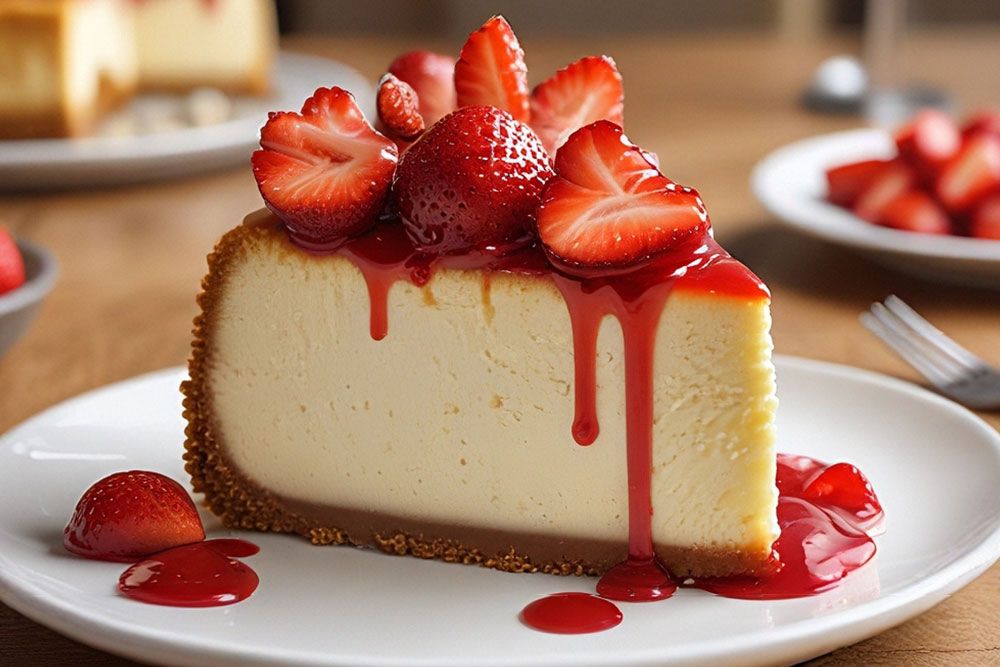Few desserts are as delectable as the New York cheesecake—a rich, creamy, and smooth delight with a wonderful textural pull. Although tangy and rich on its own, it is usually served with fruity compotes and jams. The New Yorkers’ version of the dessert contains a generous amount of cream cheese and is larger and richer than a regular cheesecake. If making it at home, certain tips can help one get the recipe right.
1. Pick good quality ingredients
The right ingredients are crucial when trying to bake the perfect New York cheesecake. The two things one must not skimp on are cream cheese and biscuits.
To give the cheesecake enough flavor, it is best to use good-quality, full-fat cream cheese. While the brand can differ based on personal preferences, keep any out for the “full-fat” tag.
For the crust, the authentic New York cheesecake recipe relies on graham crackers. If one does not mind experimenting with the recipe, they can consider giving the traditional crackers a rest and opting for speculoos or sugar cookies to give an additional burst of flavor to the New York cheesecake.
2. Use room-temperature ingredients
For a truly creamy New York-style cheesecake filling, one must ensure the ingredients reach room temperature. If any ingredients are stored in the refrigerator, one can get them out at least two hours before they begin the mixing begins. This will help keep the mixture free from lumps, resulting in a smooth and rich batter.
3. Avoid overmixing the batter
Vigorously beating the cheesecake mixture adds a lot of air to it, which eventually causes the cheesecake to rise too much in the oven. Then, after it is pulled out, this cake can crack or deflate, which can ruin its consistency and appearance.
For the best results, one must mix the cheesecake at a low or medium speed using a paddle attachment on the stand mixer. This can help one avoid adding air bubbles to the batter.
4. Use a springform pan
Getting a cheesecake out of a regular pan in one piece can be tricky. To make this simpler, one can rely on a springform pan, which makes the cheesecake much easier to serve.
5. Take measures to prevent burning
For a moist and decadent cheesecake, using a water bath is a must. A water bath is a vessel of water placed around the springform pan. This water helps the hot oven air get distributed evenly to ensure an even rise on the cheesecake. This also prevents the cheesecake from cracking.
Alternatively, one may try baking the cheesecake at a lower temperature. A sustained oven temperature of 250–300℉ would offer the cheesecake similar amounts of heat as the water bath without the risk of a soggy crust or burning.
6. Create a seal for the pan
A soggy crust is the last thing one wants for their cheesecake, as it ruins the eating experience. This generally happens when excessive moisture from the water bath seeps into the springform pan. To avoid ending up with a soggy crust, one can wrap the springform pan in foil or use a specially designed plastic wrap to create a seal that prevents water from entering.
7. Spray the pan with oil
To prevent the dessert from sticking to the pan, one can coat the springform pan with some non-stick oil spray before pouring the batter in. This simple step will make serving a breeze.
8. Avoid opening the oven door while baking
Opening the oven door while the cheesecake is baking will let all the steam out. This negatively affects the rising and baking process, so one must avoid making this mistake.
9. Keep an eye on the cheesecake
It is extremely easy to overbake a cheesecake. For a perfect bake, it is best to stop the baking process when the sides are set, and the center is slightly jiggly. If the center no longer jiggles, the cheesecake is overbaked, which can ruin its consistency and taste.
10. Chill the cheesecake before serving
Once the cheesecake has been baked, one can turn the oven off and let the cake rest inside the oven for about 30 minutes without opening the oven door. Then, one can slowly prop open the door with a wooden spoon and let the dessert rest for another 30 minutes. Any sudden differences in temperature could cause the cheesecake to crack or deflate, affecting its texture. Once the cheesecake reaches room temperature, one must pull it out of the oven and let it chill in the refrigerator for six to eight hours before serving.
Then, 20 minutes before serving time, one can remove the cheesecake from the refrigerator. First, one must run a knife around the corners to free the edges and open the springform pan. Then, one can place the cheesecake on a plate or a serving tray and cut into it as required. A classic New York cheesecake is often the best the day after it is baked, so there is no need to rush the baking or cooling process.
When baking cheesecakes, one has a lot of room to play with flavors. For instance, adding some sour cream or lemon juice to fruit-flavored cakes can amp up the zesty flavor. When making a chocolate cheesecake, one can add instant coffee powder for a rich and intense eating experience.
